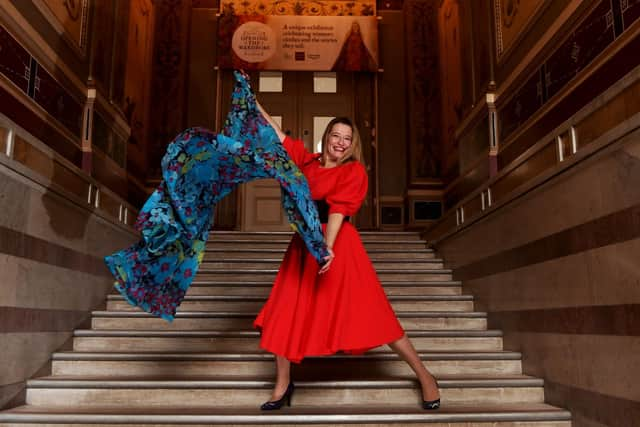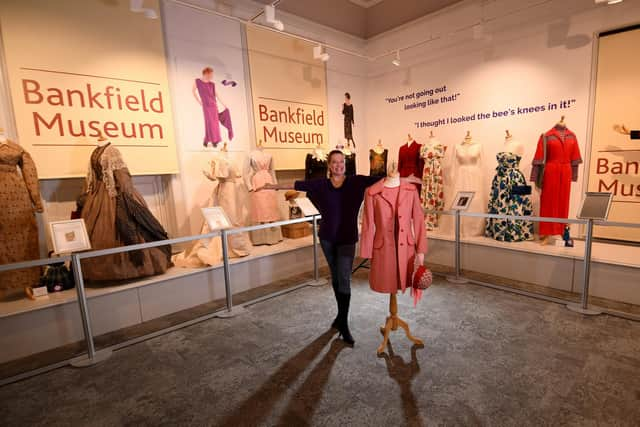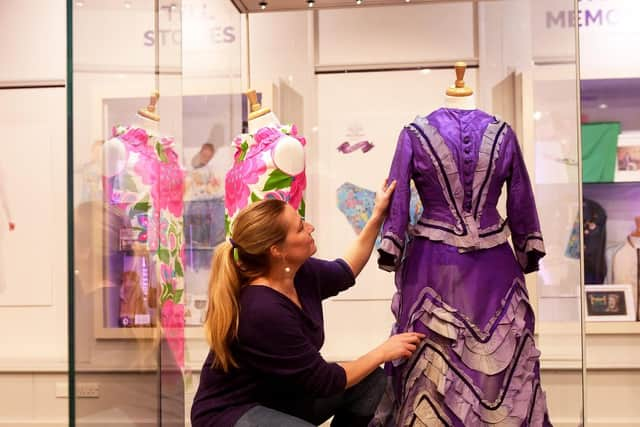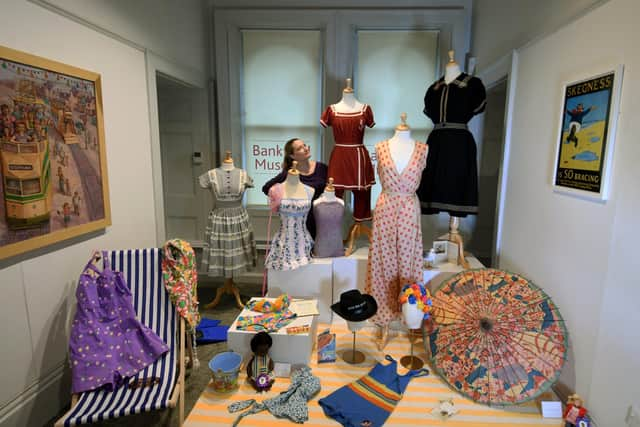From vintage school uniforms to platform boots, Opening the Wardrobe fashion exhibition in Halifax tells the story of our lives
Lucy Adlington was not always a history fan, especially not in her lessons at school in the 1980s. “It was a bit male and a bit grim, and a bit … too many kings,” she says. But she lived in the library, where one day she found a book called Costume Cavalcade, by Henny Harald Hansen, containing page after page of people in historical dress, telling their lives and stories through illustrations of what they wore. Fascinated, she kept borrowing it until she found a used copy that she could keep.
Now an author, presenter and clothes historian, Lucy has built up her own real-life collection of historical fashion, bringing together thousands of pieces of special occasion and everyday clothes, most belonging to women, from eras up to the late 20th century. Many have been given to her by attendees of her History Wardrobe talks, which she started 25 years ago and still tours across the UK in venues from village halls to museums and stately homes.
Advertisement
Hide AdAdvertisement
Hide Ad“People bring me carrier bags and old suitcases and trunks and dress bags,” she says. “They want someone to remember the people the clothes belonged to - their mam or their gran, or even themselves. One day you will get a carrier bag stuffed full of 17th century embroidery, which is gorgeous, and the next day, you’ll get someone coming in and saying, ‘I don’t know if you want this?’ and it will be something with an amazing story, like a wartime heroine.”


Some of Lucy’s collection has found a new home at Bankfield Museum in Halifax, curated for an exhibition called Opening the Wardrobe. There are examples of party and everyday wear, including school uniforms and sportswear - a genre that continues to cause outrage and embarrassment among those who just want to play sport.
“It started out with women and girls having to wear really long, heavy, wool skirts and blouses and corsetry to play hockey and tennis in the 19th century,” says Lucy. “Then gradually, you get these woolly combinations, and these shrink and shrink and shrink into gym knickers and tunics. By the 1960s and ‘70s, you were just in knickers and a T-shirt, which was really awkward, and girls started feeling self-conscious at school.”
Praise be for modern-day tracksuits and leggings but the debate rumbles on - why are female athletes expected to wear skimpy clothes even at the Olympics?
Advertisement
Hide AdAdvertisement
Hide AdOriginally from Derbyshire, Lucy lives with “a patient farmer and a cat the size of a small armchair” on a farm near York, having moved to the city 25 years ago for her MA in Medieval Studies.


Over the years, The History Wardrobe has presented costumed talks on Jane Austen (Undressing Mr Darcy proved popular), Titanic, the Suffragettes, seaside holidays and much more. Lucy delivers them with the assistance of fellow presenters and experts Lucy Ridley and Meridith Towne.
On show at Bankfield is a Zandra Rhodes pink coat found in an Oxfam shop in York. “You can really imagine it on the catwalk,” Lucy says. “There are other things that don't seem like much, like some table linens from the 1930s. They belonged to a woman I have been writing about in my last book, who survived Auschwitz concentration camp because she was a dressmaker working in a fashion salon at the camp. When you know the story, it’s really extraordinary.”
That book is an international bestseller called The Dressmakers of Auschwitz: The True Story of the Women who Sewed to Survive, and it is one of several non-fiction books Lucy has written connecting fashion and history. She is also the author of Young Adult fiction books including The Red Ribbon, The Diary of Pelly-D and Burning Mountain, all nominated and/or shortlisted for the Carnegie Medal. She is currently writing a new history book about three Jewish girls who came to England as refugees in 1939.
Advertisement
Hide AdAdvertisement
Hide AdThe exhibition also features 1960s Frank Usher dresses given at a WI group and a pair of 1970s platform boots. Lucy says: “They belong to my friend Helen, who was a really good footballer for Hull Ladies back in the day, but she is tiny. She used to go out clubbing in Leeds, and when platform boots came in, she loved it. When she got to the club, everybody else was wearing them as well.”


There is a wedding dress that had belonged to a Yorkshire nurse, given in memory of her doctor husband. “There is that lovely sense of connection with people and their happy memories, and sometimes sad memories,” Lucy says.
Her favourite fashion era is the 1940s. “Super-stylish, but you had to be really creative to get a fashionable look when things are scarce. I like the idea that women were ready for action.”
“You think it’s just clothes or fashion but, particularly the story of The Dressmakers of Auschwitz, you realise that clothes are big business.”
Advertisement
Hide AdAdvertisement
Hide AdWe are judged by what we wear. Lucy says: “We often pick outfits that show something of who we are or want to seem to be. They are also part of creativity, you want to wear certain colours or look mysterious. They tell you about the society people live in, textile technology, travel opportunities.


“What is interesting with fashion now is that we are having more conversations around how much fashion we need,” she says. The exhibition features a cabinet containing clothes that have been mended and mended. “Nowadays, perhaps we don’t take clothes seriously enough.”
*Opening the Wardrobe is at Bankfield Museum in Halifax until the end of December 2023 and is free to enter. Tickets for the presentations that run alongside at museums.calderdale.gov.uk.
